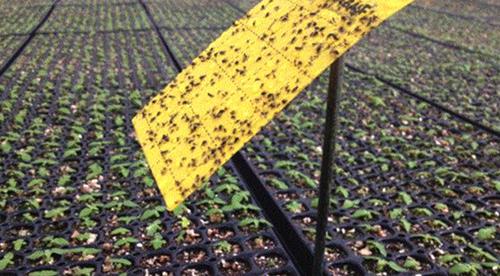As you and your team prepare for a top-notch pest-scouting season in 2026, here are some tips from Ball Seed Technical Services expert Nick Flax.
PROBLEM: A key to revamping your IPM efforts heading into next season is good scouting. I often talk with growers who, despite their best efforts, have a hard time detecting pests early enough to deploy effective preventative controls. Most often, they’ve found themselves overrun by thrips and aphids seemingly overnight and had no idea their populations were building up in the greenhouse.

NICK’S TIP: When we dig a little deeper into their scouting practices, some critical gaps are often identified. This week, I’ll cover best practices on pest monitoring and some less-common places where all of you (and your entire production team) should look for pests when scouting.
Using Sticky Card Traps
One of the most common tools we use to monitor for the presence of pests in the greenhouse is sticky traps. While use of these little 3x5 yellow (or blue) cards may seem like a no-brainer to most, I’m always surprised how many growers I work with don’t use them.
If you don’t currently use sticky cards to help monitor for pests, pick up a few packs ASAP and remember the following when you place them out in the greenhouse:
• Place one to two cards for every 500 to 1,000 sq. ft. of growing area. More can be used per unit area, but oftentimes more cards do not provide much additional actionable info.
• When placing sticky cards, ensure that they are at an appropriate height within the crop. Attach cards to a small stake that can be pushed into the growing media and lower the card to just above the crop canopy. If crawling pests like mites are a major concern, putting the trap in contact with the top edge of the container is recommended.
• Weekly “bug counts” and card swap-outs are strongly suggested, as it can be difficult to determine when pests were detected if cards are left out for longer periods. Fresh sticky traps also make it easier to assess if control measures deployed after a count were effective.
• Set IPM thresholds based on what is found on your sticky traps and make management decisions based on your findings. For example, if five thrips are found on your card in one week, deploy your first-line control measure. The following week, if 10 thrips are found on the fresh sticky card, it may be time to deploy stronger knockdown controls.
Other Places to Look
While the best place to monitor for pests is within your crops on the bench, this is not the only place you should check regularly. Several other locations that should face regular scrutiny and get a sticky card of their own include:
Hanging basket crops: Most of the time, hanging baskets are significantly out of your line of sight. This makes it very easy for pest outbreaks to occur if they go unchecked. The rule of thumb of one or two cards per 500–1,000 sq. ft. doesn’t really work in this case, so be sure to space sticky cards out in at least two or three spots along a given line of baskets. Placing a trap on the end of a line of baskets near air intakes can also help detect pests that recently entered through vents.
Greenhouse openings: Anywhere that opens to the outside is a potential entry point for flying pests. Doorways that connect directly to the greenhouse, air inlets, breezeways and louvres should each get a sticky card and be checked regularly.
Under benches: If your greenhouse floor is dirt, gravel or another permeable surface, you can be sure that pests are lying in wait down below. Some pests will lay eggs or pupate in soil below your benches, so monitoring pest movement underneath you crops can be a critical indicator of when you need to ramp up IPM measures. Incorporate under-bench bug counts into your weekly process and don’t let this practice fall by the wayside!
Drains and cisterns: In some cases, pests will hunker down in your drains and runoff collection areas between crop cycles or to escape pesticide applications. If your drainage system connects vie open channels between production areas, place a sticky trap at junctions and check them weekly during your normal count.